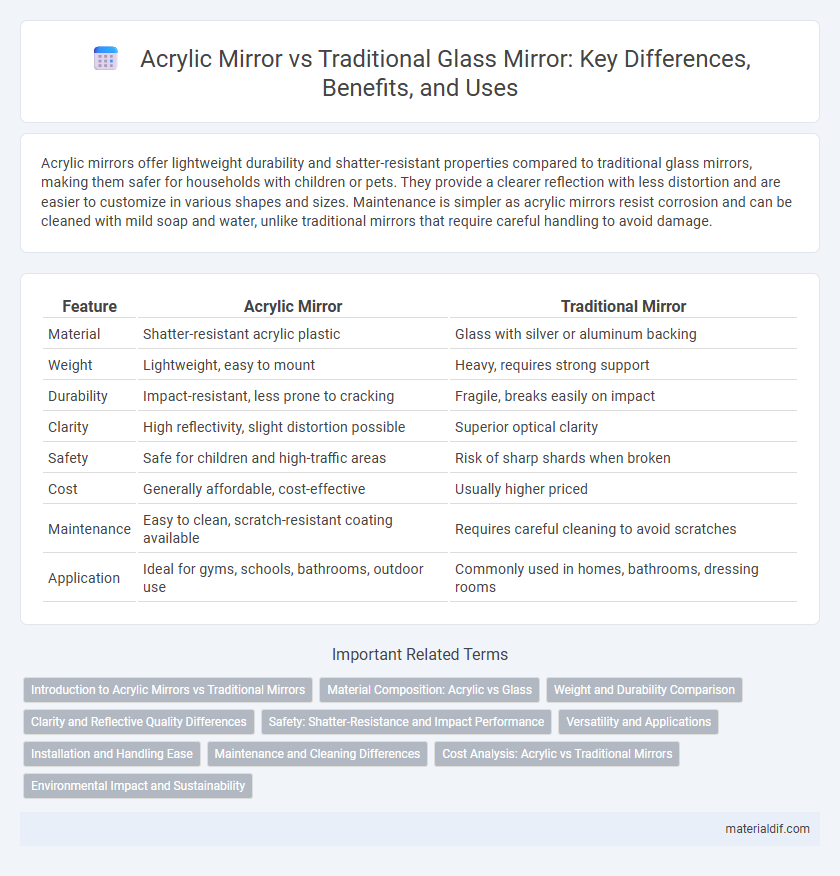Acrylic mirrors offer lightweight durability and shatter-resistant properties compared to traditional glass mirrors, making them safer for households with children or pets. They provide a clearer reflection with less distortion and are easier to customize in various shapes and sizes. Maintenance is simpler as acrylic mirrors resist corrosion and can be cleaned with mild soap and water, unlike traditional mirrors that require careful handling to avoid damage.
Table of Comparison
| Feature | Acrylic Mirror | Traditional Mirror |
|---|---|---|
| Material | Shatter-resistant acrylic plastic | Glass with silver or aluminum backing |
| Weight | Lightweight, easy to mount | Heavy, requires strong support |
| Durability | Impact-resistant, less prone to cracking | Fragile, breaks easily on impact |
| Clarity | High reflectivity, slight distortion possible | Superior optical clarity |
| Safety | Safe for children and high-traffic areas | Risk of sharp shards when broken |
| Cost | Generally affordable, cost-effective | Usually higher priced |
| Maintenance | Easy to clean, scratch-resistant coating available | Requires careful cleaning to avoid scratches |
| Application | Ideal for gyms, schools, bathrooms, outdoor use | Commonly used in homes, bathrooms, dressing rooms |
Introduction to Acrylic Mirrors vs Traditional Mirrors
Acrylic mirrors are lightweight, shatter-resistant alternatives to traditional glass mirrors, offering enhanced durability and safety for various applications. Unlike traditional mirrors that rely on glass and a reflective metallic backing, acrylic mirrors are made from polymethyl methacrylate, providing excellent optical clarity with reduced risk of breakage. Their versatility in cut shapes and sizes makes acrylic mirrors ideal for environments requiring both aesthetic appeal and functional resilience.
Material Composition: Acrylic vs Glass
Acrylic mirrors are made from polymethyl methacrylate (PMMA), a lightweight, impact-resistant plastic, while traditional mirrors consist of glass coated with a reflective metal layer such as silver or aluminum. Acrylic's material properties offer enhanced shatter resistance and flexibility compared to the brittle nature of glass mirrors. The optical clarity of glass remains superior, but acrylic mirrors provide safer and more durable options for environments prone to breakage.
Weight and Durability Comparison
Acrylic mirrors weigh up to 70% less than traditional glass mirrors, significantly reducing installation challenges and enhancing portability. Their impact resistance is approximately 10 to 24 times greater, making acrylic mirrors far more durable and less prone to shattering or chipping under stress. This combination of lightweight design and superior durability makes acrylic mirrors ideal for high-traffic areas and outdoor applications where traditional mirrors may fail.
Clarity and Reflective Quality Differences
Acrylic mirrors offer high clarity with reduced distortion due to their lightweight and flexible nature, but they typically have slightly less reflective quality compared to traditional glass mirrors. Traditional mirrors, made from glass with a silver or aluminum backing, provide superior reflectivity and sharper image details, making them ideal for applications requiring precise visual accuracy. While acrylic mirrors excel in safety and impact resistance, traditional mirrors remain unmatched in delivering crystal-clear reflections for professional and decorative use.
Safety: Shatter-Resistance and Impact Performance
Acrylic mirrors offer superior safety compared to traditional glass mirrors due to their shatter-resistant properties, significantly reducing the risk of injury upon impact. Their impact performance is enhanced by flexibility and durability, making them ideal for environments where safety is paramount, such as schools, gyms, and healthcare facilities. Unlike glass mirrors that can break into sharp shards, acrylic mirrors crack without splintering, ensuring safer handling and installation.
Versatility and Applications
Acrylic mirrors offer exceptional versatility and are ideal for a variety of applications including signage, decorative panels, and safety mirrors due to their lightweight and shatter-resistant properties. Traditional glass mirrors provide superior reflectivity and clarity, making them preferred for high-end interior design and personal grooming. The flexibility of acrylic mirrors allows them to be cut, shaped, and installed in environments where glass mirrors may pose risks or be impractical.
Installation and Handling Ease
Acrylic mirrors offer significantly easier installation and handling compared to traditional glass mirrors due to their lightweight and shatter-resistant properties. Their flexible nature allows for creative mounting options and reduces the risk of injury during setup. Traditional mirrors, made of glass, require careful handling and support structures to prevent breakage and ensure safe installation.
Maintenance and Cleaning Differences
Acrylic mirrors require less maintenance compared to traditional glass mirrors due to their shatter-resistant and lightweight properties, which reduce the risk of damage during cleaning. Unlike traditional mirrors that need special glass cleaners to avoid streaks or damage to the reflective coating, acrylic mirrors can be safely cleaned with mild soap and water or non-abrasive cleaners. Additionally, acrylic's scratch-resistant surface allows for easier upkeep without the need for frequent polishing or professional restoration.
Cost Analysis: Acrylic vs Traditional Mirrors
Acrylic mirrors generally cost 30-50% less than traditional glass mirrors due to lower material and manufacturing expenses. They are lightweight, reducing installation and shipping costs, especially beneficial for large mirrors or custom shapes. While traditional mirrors often have longer durability, acrylic mirrors offer cost-effective alternatives for budget-conscious projects without significant compromise on reflective quality.
Environmental Impact and Sustainability
Acrylic mirrors have a significantly lower environmental footprint compared to traditional glass mirrors due to their lightweight nature, reducing transportation emissions and energy consumption during manufacturing. Unlike glass mirrors, which involve energy-intensive melting and use heavy metals for reflective coatings, acrylic mirrors often utilize less toxic materials and are more easily recyclable. Their durability and resistance to breakage also extend product lifespan, decreasing waste and promoting sustainability in the long term.
Acrylic Mirror vs Traditional Mirror Infographic

 materialdif.com
materialdif.com